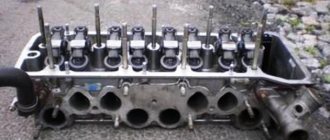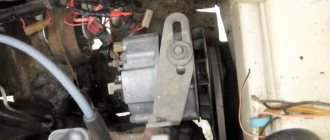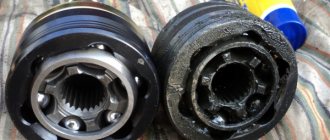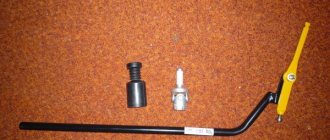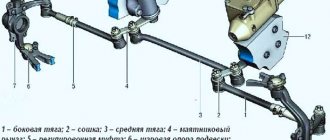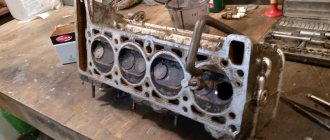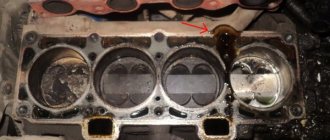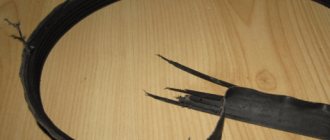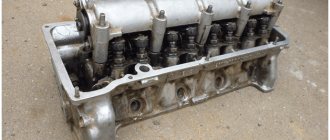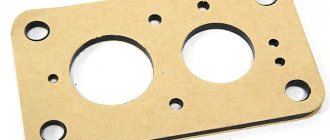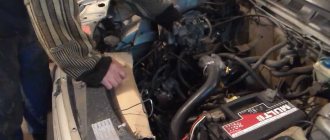03/02/2022 10,554 Cylinder block
Author: Victor
Domestic cars have a fairly simple design, which allows them to be repaired on their own. Replacing the Kalina cylinder head gasket can be done independently, but only if you have a garage, a good set of tools and the owner has experience.
[Hide]
Frequency and signs of replacement
There is no specific time frame for replacing the cylinder head gasket on the Lada Kalina. Over time, it can become unusable under the influence of various factors. The gasket can break through in different places and, depending on the location of the crack, the signs of damage will be different. The symptoms will be the same for both 8-valve and 16-valve engines.
Symptoms of gasket damage:
- When the gasket breaks along the side of the cylinder circumference, gases begin to escape outward. At the same time, the noise level of the VAZ Kalina engine increases sharply, which will be immediately noticeable to the driver.
- A hole between the cylinders disrupts the operating mode and the engine begins to operate unevenly and triple.
- Destruction of the gasket with a rupture entering the coolant supply channels. At the same time, gases begin to enter the cooling system. One of the external signs of such a problem will be a decrease in the fluid level and the appearance of white steam in the exhaust gases. Gas bubbles may appear in the expansion tank. Another sign is the appearance of an emulsion in the oil, accompanied by an increase in the level of lubricant in the crankcase. Oil can also go into the cooling system, which is easy to detect by its presence on the surface of the liquid in the expansion tank.
- Another indirect symptom of a gasket burnout is the appearance of stains or leaks of oil or coolant on the parting line of parts and on the side surface of the engine crankcase.
Removing the cylinder head viburnum
Domestic cars have a fairly simple design, which allows them to be repaired on their own. Replacing the K Alina cylinder head gasket can be done independently, but only if you have a garage, a good set of tools and the owner has experience.
Frequency and signs of replacement
How to replace it yourself?
Step by step instructions (8 valves)
Step by step instructions (16 valves)
Gasket selection
When purchasing a gasket, you need to know the type of engine installed on Kalina. There are two versions of 8-valve engines - VAZ 11183 and VAZ 11186. These engines have different piston groups and differ in many external elements. On the older version 11183, a thickness of 1.2 mm is used (article 21080-1003020-12, manufacturer ZAO Lada-Image), and the new 11186 requires a gasket with a thickness of only 0.43 mm. This nuance must be taken into account when choosing new parts. For a 1.4-liter 16 valve engine, a gasket 11194-1003020-00 manufactured by Federal-Mogul Corporation is required, or you can get a cheaper option from Trialli (GZ1015001).
How to replace it yourself?
Replacing a burnt gasket requires a large amount of work. Self-repair and replacement of the Kalina cylinder head gasket can only be carried out by an experienced car owner who has the skills to disassemble and reassemble engines. For novice drivers and people who are not confident in their capabilities, contacting a specialized service would be an advisable step.
Tools and materials
Before starting work, you need to find a room for the replacement and check the availability of the necessary tools and equipment.
The minimum set of tools and spare parts is as follows:
- new cylinder head gasket;
- 10 bolts for cylinder head with size M12 (article 026707, for motor 11183) and M10 (article 256632, for engine 11186);
- gasket for the junction of the catalytic converter and resonator housings;
- torque wrench up to 100 Nm;
- a set of hex keys and sockets (at least sizes 10, 13, 17 and 19);
- pliers;
- screwdrivers with different types of blades;
- rags for wiping;
- container for draining coolant.
It is not recommended to use old cylinder head bolts.
Step by step instructions (8 valves)
After preparing the tools, you can begin replacing. The gasket replacement procedure is quite lengthy and takes about 8-9 hours even for experienced craftsmen.
Below is an approximate sequence of actions when replacing the cylinder head gasket of a Kalina with a 1.6-liter 8-valve engine:
- Place the car over the inspection hole.
- Remove the fuse box cover located on the center console and remove the fuel pump fuse.
- Start the engine and drain fuel from the ramp. Turn off the engine.
- Disconnect the battery and remove it from the vehicle.
- Replace the fuse and cover.
- Unfasten the decorative plastic casing from the motor. To do this, you need to pull it up and pull off the rubber caps from the studs. Inspect these caps; damaged parts should be replaced.
- Remove the three bolts securing the upper part of the camshaft drive belt housing.
- Separate the cover and manually turn the engine crankshaft to TDC (top dead center) in the first cylinder. The guideline will be the coincidence of the notch on the camshaft gear with the notch on the rear of the housing.
- Remove the plug located on the clutch housing and check the location of the mark on the flywheel and housing. The marks must match.
- Secure the engine flywheel with a screwdriver through the hole in the crankcase and unscrew the camshaft gear.
- Remove the timing belt drive.
- Remove the ignition coil attached to the bracket with four screws.
- Remove the engine sump protective shield. Drain the coolant from the cylinder block. To do this, you need to open the expansion tank cap and unscrew the screw plug on the side of the crankcase. Pour the liquid into a prepared container.
- Disconnect the lines from the thermostat and throttle valve assembly.
- Separate the air duct from the throttle body and remove the air filter housing.
- Step by step disconnect the electrical wiring connectors for the idle speed (IAC), throttle position (TPS), fluid temperature and oil pressure sensors.
- Disconnect the ground wire from the engine.
- Disconnect the injector connectors.
- Remove the fitting and separate the fuel supply pipe from the ramp.
- Remove the two bolts securing the ramp to the intake manifold housing.
- Carefully move the ramp along the axis of the injectors and remove them from their seats on the manifold.
- Remove the brake booster hose attached to the throttle body fitting.
- Unfasten the intake pipe spacer mounted on the nuts.
- Remove the lambda probe connectors on the catalytic converter.
- Unscrew the receiving pipe going to the muffler from the flange of the gas neutralizer.
- Remove the neutralizer support bracket.
- Loosen the head bolts according to the diagram and unscrew them completely. When removing bolts, they must be removed along with washers.
- Remove the head from the engine.
- Remove the old gasket.
- It is advisable to send the removed head for surface milling, since it may have microcracks that arose when the engine was running with a broken gasket.
- After checking, you can put the head back, having first checked the presence and completeness of installation of the guide bushings.
- Thoroughly wipe the mating surfaces of the block and head from oil and coolant. Clean the bolt wells from liquids.
- Carefully wash the cylinders with gasoline to remove deposits.
- Place a new gasket on the block, centering it along the guide bushings. The channel for the passage of oil through the gasket is located between the third and fourth cylinders - it is important not to miss this moment.
- When reinstalling the head, it is necessary to set the position of the shafts corresponding to TDC in the first cylinder (according to the marks).
- Tighten the bolts according to the scheme in several passes - initial tightening with a force of 20 Nm, tightening with a torque of 70–85 Nm, the first turn by 90 degrees and the second turn by another 90 degrees. When installing the head, use only new bolts and lubricate them with a thin layer of engine oil, which will facilitate tightening.
- Reinstall all removed parts.
- During assembly, it is recommended to check and adjust the valve clearances, as well as check the tension of the drive belt and the correct timing of the gas distribution mechanism.
- Turn the assembled engine over by hand several times and re-check the timing timing.
- Start the engine, make sure there are no leaks or extraneous sounds. Warm it up, visually monitoring its condition.
- Remove the coolant pipes from the throttle body assembly. Release the air from them, gradually increasing engine speed. Put the tubes back on and add fluid to the tank to the normal level.
Sequence of loosening bolts
Bolt tightening order
Video from the channel Sdelaj Sam! Pljus interesting! Demonstrates basic methods for identifying faults and replacing worn parts.
Step by step instructions (16 valves)
Removing the head for replacement on such motors has its own characteristics that must be taken into account during disassembly and reassembly. The engine design is much more complex than the 8-valve version and requires careful assembly and subsequent adjustment of the valve timing.
How to remove the head from a 1.4-liter 16-valve engine with an injector, model VAZ 11194:
- By analogy with an 8-valve engine, it is necessary to drain the fuel from the line, remove the battery, decorative casing, and air filter. And also drain the coolant and disconnect all sensor connectors.
- Remove the breather pipe and vacuum booster hose.
- Disconnect the hoses from the throttle body and the throttle position sensor.
- Remove the ignition coils.
- Disconnect the wiring harnesses and fluid supply pipes from the windshield washer reservoir. Remove the tank itself.
- Loosen the tension on the accessory drive belt and remove it.
- Remove the camshaft drive belt guard and fuel rail. The injectors are removed using a scheme similar to the 8-valve engine.
- Move the generator towards the radiator and remove the oil level dipstick guide.
- Remove the receiver mount to the block head.
- Unscrew the lower timing belt cover.
- Unscrew the fastenings of the timing belt tension rollers and the crankshaft pulley and remove them together with the belt.
- Remove the camshaft gears.
- Unscrew the 15 bolts and remove the camshaft cover.
- Unscrew the 20 bolts that secure the camshaft supports.
- Remove the shafts.
- Remove the hydraulic compensators.
- Unscrew the attachment points of the neutralizer to the head.
- Disconnect all hoses from the thermostat.
- Unscrew the 10 head mounting bolts (according to the diagram).
- Remove the head and replace the gasket.
- Reassemble, taking into account the recommendations for the 8-valve engine.
Head removal procedure
Bolt tightening order
Repair of cylinder head of Lada Kalina 8 valves
8. Disconnect the tips of the high-voltage wires from the spark plugs.
9. Disconnect the wires from the oil pressure warning light sensor. 10. Disconnect the wires from the coolant temperature sensor (coolant temperature sensor) of the engine management system and the phase sensor. 11. Remove the cylinder head cover (see “Replacing the cylinder head cover gasket”). 12. Remove the front camshaft drive cover (see “Installing the piston of the first cylinder to the TDC position of the compression stroke”).
This lasted for up to a year and a half. The options were remarkable, as there were not only American matrix models, including the Impala, which was imported and sold here, but also European cars, which were smaller and more fuel efficient. The differences between the Record and Opal were mainly in the headlights, taillights and bumpers.
The headlights were round, unlike the rectangular records, with a grid of chrome horizontal friezes and flashers mounted under the bumper. In the center of the rear panel was the fuel tank cap. The hubcaps were solid chrome and the tires were in some cases white. Exaggeration: The two versions seated six people because the front seats were single—there was no choice of individual seats. The gear lever was located in the steering column and the dash was simple with the necessary dials, and the steering wheel was two-spoke.
13. Loosen the camshaft pulley bolt while holding the camshaft from turning (this can be done by inserting a large screwdriver or spudger into the pulley hub holes). 14. Remove the timing belt (see “Replacing the timing belt (camshaft drive) and tension roller”). 15. Completely unscrew the camshaft pulley mounting bolt and remove the pulley. 16. Remove the rear camshaft drive cover (see “
They were both very traditional, with a cast iron block and head, a control valve on the block, valve actuation via rods and rockers, and a single body carburetor. The six-cylinder crankshaft had seven crankshafts, so they were quiet, strong and very smooth. The valves used hydraulic lifters, eliminating the need for lash adjustments, making maintenance easier.
This was easily solved by using a special intake manifold and the use of two or three dual carburetors, widely used on the tracks later. As bad characteristics, it vibrated a lot and was rough. The front suspension was mounted under the chassis.
Material from the Encyclopedia of the magazine "Behind the Wheel"
Price issue
Changing the head gasket yourself will be quite inexpensive, since its cost ranges from 220 (for 8-valve engines) to 550 rubles (for 16-valve engines). In addition to it, you will need a gasket between the exhaust pipe and the catalyst, which costs no more than 100 rubles, and 10 new head bolts, costing 40–50 rubles each. Often the manifold gasket is damaged, which in this case must be replaced. A new part costs about 750 rubles. The total cost of spare parts will not exceed 1,500 rubles. It must be remembered that when disassembling and troubleshooting the engine, other parts may appear that need to be replaced.
Performing such work at a service station depends on the territorial location and ranges from 4 thousand rubles in small cities (Tula, Bryansk) and up to 10 thousand rubles in large cities (Moscow, St. Petersburg).
Rear suspension Lada Kalina / Lada Kalina (VAZ 1118, 117, 1119)
Tightening torques for threaded connections
Name of units and parts
Wheel bolts
Rear wheel bearing nut
Bolt nut for the lower shock absorber mounting to the rear suspension arm
Nut securing the rear suspension shock absorber rod to the body
Nuts of bolts securing the rear suspension arm to the bracket
Nuts securing the rear suspension arm bracket to the body
The rear suspension of the car is semi-independent, made on an “elastic” beam with trailing arms, coil springs and double-acting telescopic shock absorbers.
The rear suspension beam consists of two trailing arms connected by a U-shaped cross member. This cross-section provides the connector (cross member) with greater bending rigidity and less torsional rigidity. The connector allows the levers to move relative to each other within small limits. The levers are made of pipes of variable cross-section, which gives them the necessary rigidity. Brackets are welded to the rear end of each lever for attaching the shock absorber, rear brake assembly and wheel hub axle. At the front, the beam arms are bolted to removable brackets for the body side members. The mobility of the levers is ensured by rubber-metal hinges (silent blocks) pressed into the front ends of the levers.
The lower shock absorber eye is attached to the beam arm bracket. The shock absorber is attached to the body by a rod with a nut. The elasticity of the upper and lower connections of the shock absorber is provided by a rod cushion and a rubber-metal bushing pressed into the eye. The shock absorber rod is covered with a corrugated casing that protects it from dirt and moisture. In the event of suspension breakdowns, the shock absorber rod stroke is limited by a compression stroke buffer made of elastic plastic.
The suspension spring with its lower coil rests on the support cup (a stamped steel plate welded to the shock absorber body), and with its upper coil it rests against the body through a rubber gasket.
The rear wheel hub axle is installed on the flange of the beam arm bracket (it is secured with four bolts). The hub with a double-row roller bearing pressed into it is held on the axle by a special nut. The nut has an annular collar that securely locks the nut by jamming it into the groove of the axle. The hub bearing is a closed type and does not require adjustment or lubrication during vehicle operation.-
Rear suspension shock absorber spring: 1 - spring; 2 — rubber gasket; 3 — casing cover; 4, 10 — shock absorber rod cushion; 5 — spacer sleeve; 6 — shock absorber casing; 7 - nut; 8 — spring washer; 9 — support washer; 11 — shock absorber rod; 12 — shock absorber body; 13 — lower spring support plate; 14 — nut of the shock absorber lower mounting bolt; 15 - eye; 16 — bolt of the lower shock absorber mounting; 17 - compression progress buffer
Photo gallery
The photo below shows some stages of replacing the gasket on an 8-valve VAZ engine.
Engine with valve cover removed
Unscrewing the exhaust pipe from the converter
Interior of engine cylinders with damaged gasket
The gasket itself
Place of gasket punching
Cylinders washed with gasoline
Head removed from engine
Carbon deposits on valves and combustion chambers
The photo below shows some of the stages of disassembling a 1.4 liter engine.
Removing the washer reservoir
Removed ramp with injectors
Probe guide
Timing drive removed
Camshaft gears removed
Removing the camshaft supports
Cylinder interior
16 valve head
Video
The video shows the identification of the malfunction and the process of changing a broken gasket on Kalina (by Sdelaj Sam! Pljus interesnoe!)
Do you have any questions? Specialists and readers of the AUTODVIG website will help you ask a question
Was this article helpful?
Thank you for your opinion!
The article was useful. Please share the information with your friends.
Yes (50.00%)
No (50.00%)
X
Please write what is wrong and leave recommendations on the article
Cancel reply
Rate this article: ( 6 votes, average: 4.50 out of 5)
Discuss the article:
